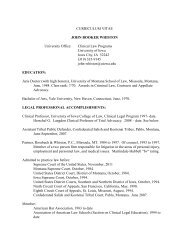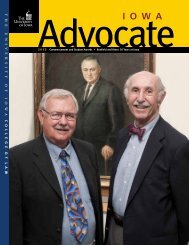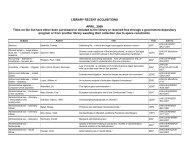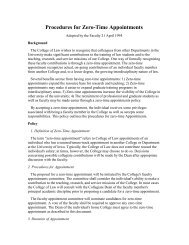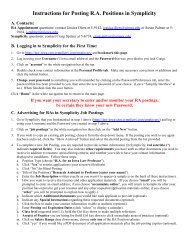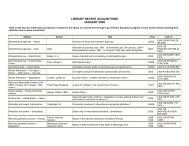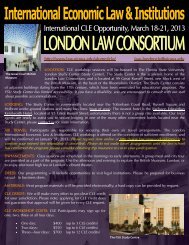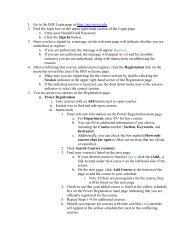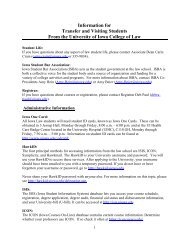Free Writing Steve Thel*
Free Writing Steve Thel*
Free Writing Steve Thel*
- No tags were found...
Create successful ePaper yourself
Turn your PDF publications into a flip-book with our unique Google optimized e-Paper software.
Thel Final9/18/2008 1:11 PM974 The Journal of Corporation Law [Vol. 33:4C. <strong>Free</strong> <strong>Writing</strong> Prospectuses Should Be Exempt from Section 12(a)(2) If They Are NotBroadly Disseminated Before a Final Section 10(a) Prospectus Is AvailableEven if the SEC could have done a better job if it wanted to assure that false freewriting prospectuses would be actionable under section 12(a)(2), the more importantquestion is whether free writing prospectuses should be subject to such actions at all.The SEC‟s 2005 reforms were generally welcomed by Wall Street. The new rulessubstantially trimmed section 5 restrictions on written communications, and, except forthe expansion of issuer liability under section 12(a)(2), the Commission did not createany new burdens that market participants cannot avoid by the simple expedient of leavingthe new tools unused. 164 Moreover, the new rules provide a clear framework pursuant towhich written and electronic communications can now be broadly disseminated withoutviolating section 5(b)(1). Accordingly, the general effect of the reforms is simply to givethose distributing securities new flexibility, albeit flexibility accompanied by section12(a)(2) liability, that they can choose to use or not.Changes in the public offering process since 1933 would make it inappropriate toexempt all free writing prospectuses from section 12(a)(2). Securities may not be sold ina public offering until the registration statement becomes effective, and for a long timeregistration statements did not become effective until a complete section 10(a) prospectushad been filed with the Commission. Thus when the Securities Act was adopted, acomplete section 10(a) prospectus was available before anyone purchased securities in apublic offering. Even before the 2005 reforms were adopted, however, registrationstatements could become effective without a variety of information relating to the priceof the securities being offered, including the total proceeds to the issuer. 165 Moreover,with the abolition of the statute of frauds for securities transactions, investors can enterbinding contracts to purchase securities before receiving any written document. 166 Whiledealers must distribute preliminary prospectuses before confirming sales in initial public164. This statement must be qualified by the possibility, discussed infra Part V, that Gustafson stands forthe proposition that only standardized offering documents of broad distribution are subject to section 12(a)(2).The SEC contemplated that some free writing prospectuses will not be broadly distributed documents, and thusdispensed with filing requirements for free writing prospectuses distributed by non-issuers in a manner notreasonably designed to lead to broad unrestricted distribution. Rule 433(d)(1)(ii), 17 C.F.R. § 230.433(d)(1)(ii)(2007). The rules seem designed to preclude any argument that a free writing prospectus that is not widelydisseminated is exempt from liability under Gustafson. See Rule 433(a), 17 C.F.R. § 230.433(a) (2007) (“[A]free writing prospectus . . . will, for purposes of considering it a prospectus, be deemed to be public, withoutregard to its method of use or distribution, because it is related to the public offering of securities that are thesubject of a filed registration statement.”).165. See Rule 430A, 17 C.F.R. § 230.430A (2007) (listing the information that a prospectus filed as part ofa registration statement that is declared effective may omit); see also Securities Offering Reform, supra note 1,at 44,765-66 (explaining that “Section 12(a)(2) and Section 17(a)(2) do not require that . . . the prospectus . . .contain all material information”).166. U.C.C. § 8-319 (2005). When the Securities Act was enacted, securities transactions were generallysubject to the statute of frauds, so that a buyer was not bound until she had received a confirmation of the trade.A confirmation is itself a prospectus within the meaning of the Securities Act, so the only way a dealer couldsend a confirmation was to accompany or precede it with a section 10(a) prospectus, thereby converting theconfirmation to free writing. Thus investors received a section 10(a) prospectus at some point, although oftenafter they had made their investment decisions.




